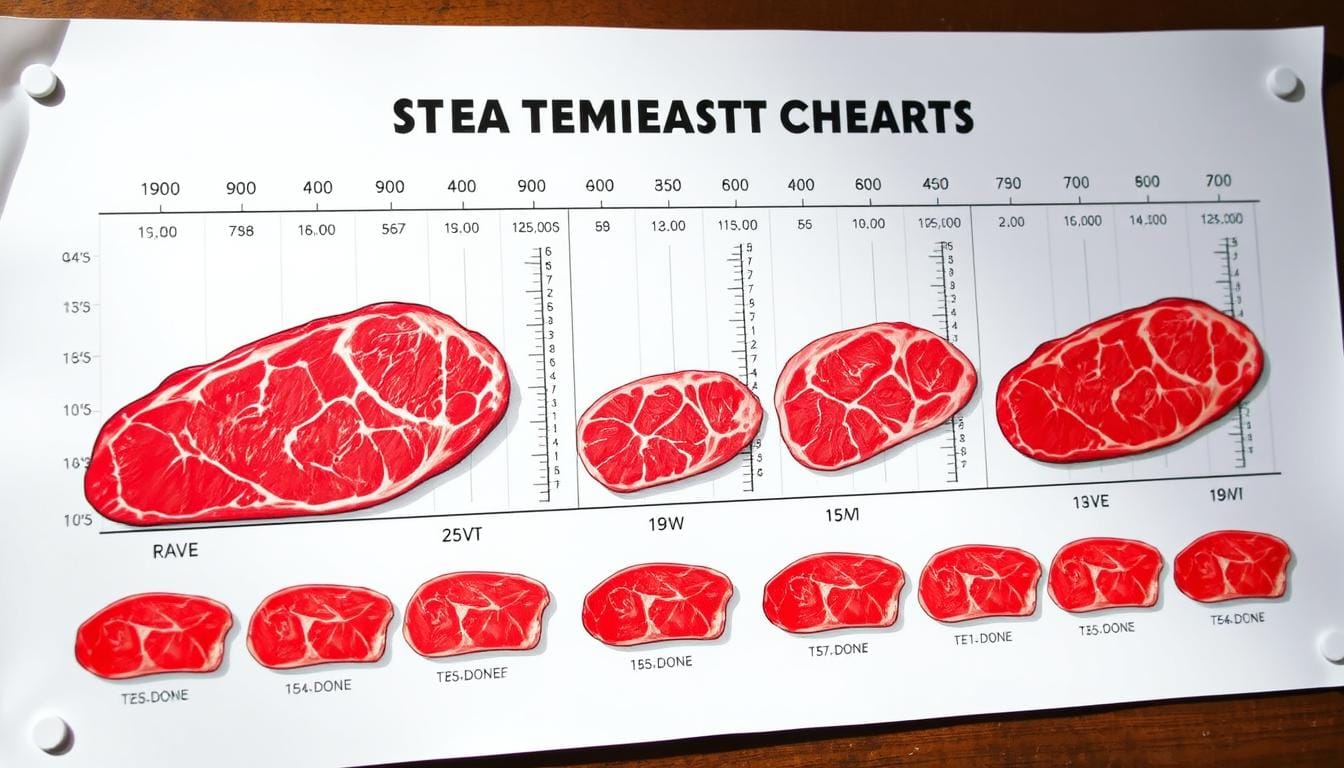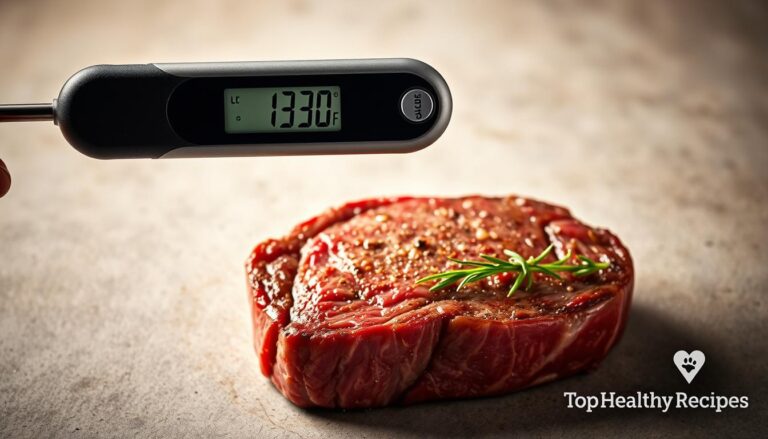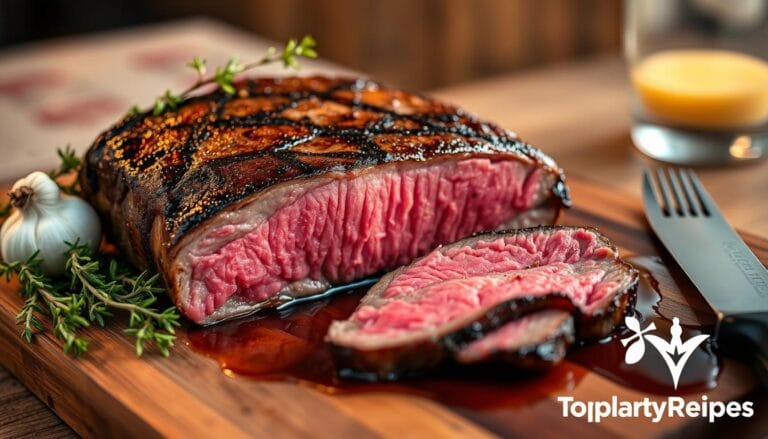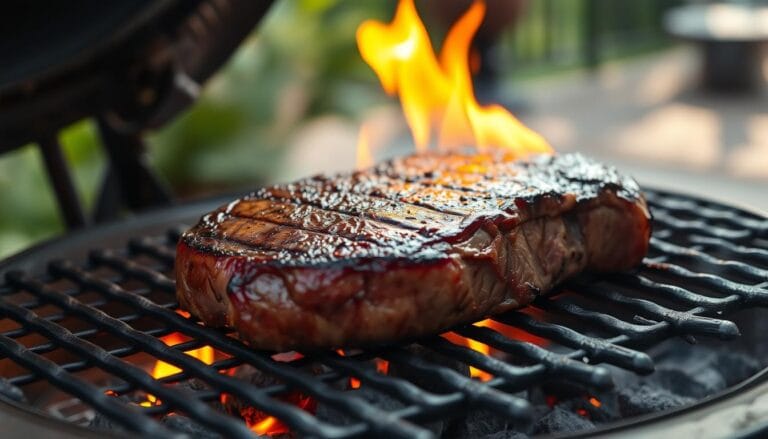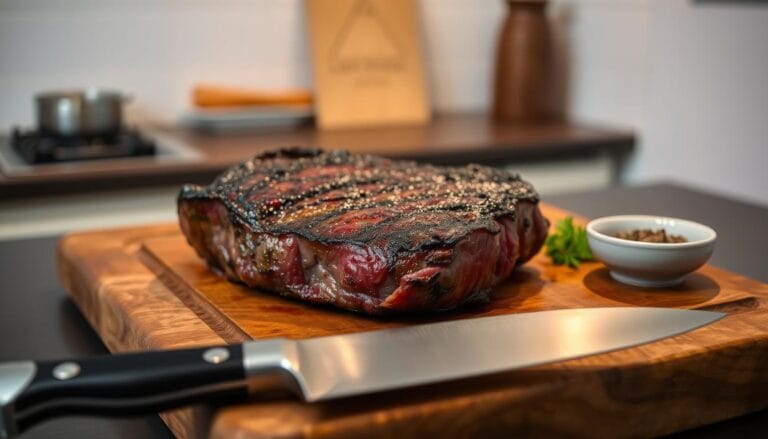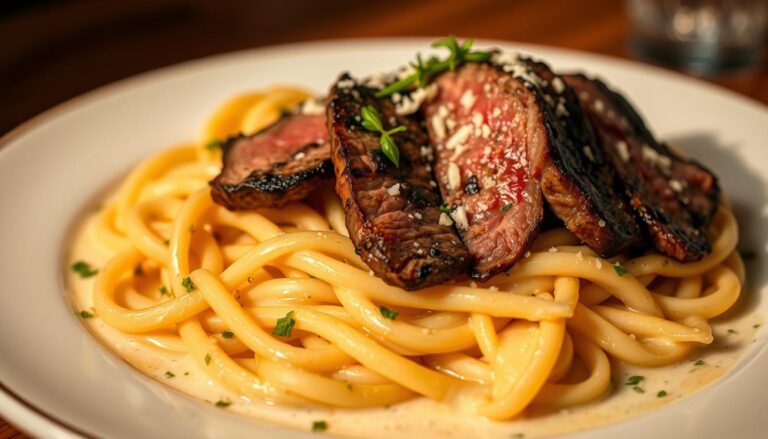What Temp Is a Medium Rare Steak? Nail That Perfect Pink Center!
Table of Contents
What Temp Is a Medium Rare Steak? Nail That Perfect Pink Center!
Cooking the perfect steak can seem hard, mainly because of the internal temperature mystery. Whether you’re new to cooking or have years of experience, getting the doneness right is key for a great meal.
It’s common to end up with a steak that’s too raw or too cooked. This guide will show you how to cook steak to your liking, from rare to well done. We’ll use a trusted temperature chart to help you.
Knowing the exact internal temp for each doneness level lets you make a tasty steak every time. You’ll meet your steak expectations with ease.
Key Takeaways
- Learn how to cook steak to the perfect doneness every time.
- Understand the ideal internal temperatures for different levels of doneness.
- Use a reliable temperature chart to achieve restaurant-quality results at home.
- Discover the simple tools and techniques needed to cook steak to your liking.
- Gain confidence in your ability to prepare a delicious steak.
Understanding Steak Doneness Levels
The secret to a great steak is knowing its doneness levels. Doneness is how cooked a steak is. It affects its taste, texture, and your dining experience.
What is Steak Doneness?
Steak doneness is about the steak’s internal temperature. This is more reliable than cooking time or looks. The temperature changes the steak’s texture and juiciness.
Internal temperature is key. It’s hard to tell doneness by color or texture alone. A steak can look the same on the outside but be different inside.
Importance of Internal Temperature
The importance of internal temperature is huge. It’s the best way to check if your steak is cooked right. Relying on cooking time can be tricky because of steak thickness and heat.
Using a thermometer makes cooking steak easier. For example, a medium rare steak is between 130°F and 135°F (54°C to 57°C). This ensures your steak is cooked perfectly.
Common Terminology Explained
Knowing steak doneness terms is key. Terms like “rare,” “medium-rare,” “medium,” “medium-well,” and “well-done” tell you the steak’s temperature and texture.
- Rare: 120°F – 130°F (49°C – 54°C), red and juicy.
- Medium-Rare: 130°F – 135°F (54°C – 57°C), warm red center.
- Medium: 140°F – 145°F (60°C – 63°C), pink throughout.
- Medium-Well: 150°F – 155°F (66°C – 68°C), slightly pink.
- Well-Done: 160°F – 170°F (71°C – 77°C), fully cooked.
By knowing these terms and using internal temperature, you can make the perfect steak every time.
Ideal Internal Temperatures for Steak
To cook steak perfectly, knowing the internal temperatures for different doneness levels is key. The internal temperature is vital for achieving the desired doneness. Whether you like your steak rare, medium-rare, medium, medium-well, or well-done, it matters.
Temperature Chart for Different Doneness Levels
The ideal internal temperatures for steak depend on the desired doneness. Here’s a general guideline:
- Rare: 120-125°F
- Medium-rare: 130-135°F
- Medium: 140-145°F
- Medium-well: 150-155°F
- Well-done: 160°F and above
For a medium steak temperature, aim for 140-145°F. If you prefer medium-rare, the internal temperature should be 130-135°F. This answers the question of what temp is medium rare steak.
Recommended Temperatures by Cut
Different steak cuts need slightly different temperatures. This is due to differences in fat content, muscle structure, and thickness. For example, fattier cuts like ribeye can handle higher temperatures better than leaner cuts like filet mignon.
| Steak Cut | Recommended Internal Temperature |
|---|---|
| Ribeye | 130-135°F (medium-rare) |
| Filet Mignon | 125-130°F (rare to medium-rare) |
| Skirt Steak | 130-135°F (medium-rare) |
How to Use This Temperature Guide
To get consistent results, it’s important to use the temperature guide well. This includes considering carryover cooking and adjusting for personal taste.
By following these guidelines and using a meat thermometer, you can ensure your steak is cooked just right every time.
Measuring Internal Temperature Correctly
The secret to a perfect steak is knowing its internal temperature. This step is key to cooking your steak just right. Whether you like it rare, medium rare, or well done, it’s all about the temperature.
Tools for Accurate Temperature Measurement
To get the steak’s internal temperature right, you need a good meat thermometer. There are many types out there. You can choose from instant-read digital thermometers, probe thermometers, or even wireless smart thermometers. Each has its own benefits, depending on how you cook and what you prefer.
- Instant-read digital thermometers give quick and precise readings. They’re great for checking the temperature at the end of cooking.
- Probe thermometers let you keep an eye on the temperature as it changes. They’re perfect for cooking methods that need a steady temperature.
- Wireless smart thermometers make it easy to monitor the temperature from afar. They’ll alert you when your steak is ready.
Best Practices for Using a Meat Thermometer
Getting the most out of your meat thermometer means using it right. Here are some tips:
- Put the thermometer in the thickest part of the steak, away from bones or fat.
- Wait for the thermometer to settle before reading it, which is important for digital ones.
- Check the temperature in different spots to make sure it’s even, which is more important for bigger steaks.
Common Mistakes to Avoid
Staying away from common mistakes with your meat thermometer can make a big difference. Some mistakes to avoid include:
- Checking the temperature too soon, before the steak has fully cooked.
- Putting the thermometer too near bones or fat, which can give wrong readings.
- Not waiting long enough for digital thermometers to show the correct temperature.
By learning how to use a meat thermometer well and avoiding common mistakes, you’ll cook steaks that are always just right. This will make every meal a great one.
Cooking Methods and Their Effects on Temperature
Cooking techniques are key to getting the perfect steak. Different methods change how heat spreads and is absorbed. This affects the steak’s doneness.
Grilling: Heat Distribution and Doneness
Grilling is a favorite way to cook steak. It gives a charred outside and a juicy inside if done right. It’s important to manage heat well.
Direct heat is best for searing, making the steak flavorful. Indirect heat cooks the steak gently. This helps get the right temperature without burning the outside.
Tips for Grilling:
- Preheat your grill to ensure a consistent temperature.
- Use tongs or a spatula to flip the steak, avoiding piercing the meat with a fork.
- For a medium-well steak, grill until it reaches an internal temperature of around 150°F to 155°F.
Baking: Achieving Consistent Results
Baking steak in the oven is another good method. Using a cast-iron skillet for searing before baking gives a nice crust and a perfectly cooked inside.
The oven temperature is key. A high temperature at first sears the steak. Then, a lower temperature finishes it off to the right doneness.
| Doneness Level | Internal Temperature | Oven Temperature |
|---|---|---|
| Rare | 120°F – 130°F | 400°F (Sear), then 300°F |
| Medium Well | 150°F – 155°F | 400°F (Sear), then 325°F |
| Well Done | 160°F+ | 400°F (Sear), then 325°F |
Sous Vide: Precision Cooking Explained
Sous vide cooking gives you precise temperature control. It cooks the steak evenly from edge to edge. You seal the steak in a bag and cook it in a water bath at a set temperature.
“Sous vide machines have revolutionized the way we cook steak, providing unparalleled control over the cooking process.” – Chef, culinary expert
After sous vide cooking, a quick sear in a hot pan adds flavor. This method is great for a consistent beef medium well temp in the steak.
Factors Influencing Steak Temperature
Knowing what affects steak temperature is key to getting it just right. Several things influence how your steak reaches its perfect internal temperature.
Three main factors impact steak temperature: steak thickness, starting meat temperature, and cooking time. Let’s dive into each one.
Thickness of the Steak
The steak’s thickness is a big deal for its internal temperature. Thicker steaks need more time for heat to reach the center. Thinner steaks cook faster, with less room for error.
For example, a1-inch thick steak cooks quicker than a2-inch thick steak. Adjusting cooking time is vital for steaks of different thicknesses.
Starting Temperature of the Meat
The meat’s starting temperature is also important. Letting steaks come to room temperature before cooking helps. This step ensures even cooking and better results.
Cooking Time and Its Impact
Cooking time and heat intensity are critical. High heat gives a quick sear, while low heat cooks more slowly. Knowing when to use each is essential for the right internal temperature.
- Cooking time changes with steak thickness and desired doneness.
- High heat sears quickly but may not cook evenly.
- Low heat cooks evenly but lacks a sear.
Tips for Achieving Perfectly Cooked Steak
Getting a perfectly cooked steak is a goal that needs focus and some key techniques. It doesn’t matter if you’re an expert or just starting out. Knowing how to cook steak well can make your dishes much better.
Preheating and Its Importance
It’s key to preheat your cooking area, like a grill, pan, or oven, before cooking. A hot surface helps the steak cook evenly and fast. This is important for getting the steak just right.
For grilling, heat it up to 450°F to 500°F for a nice char. When pan-searing, use a skillet that can handle high heat and preheat it until it’s almost smoking.
Resting Time for Optimal Juiciness
After cooking your steak, let it rest. This step makes the steak tender and juicy. The resting time depends on the steak’s thickness, but 5 to 10 minutes is usually enough.
While it rests, the steak’s internal temperature will also stabilize. This makes it easier to get the perfect doneness.
| Steak Thickness | Recommended Resting Time |
|---|---|
| 1 inch | 5 minutes |
| 1.5 inches | 7-8 minutes |
| 2 inches | 10 minutes |
Seasoning Tips for Enhanced Flavor
Seasoning is a big part of making a tasty steak. Season with salt and pepper generously before cooking. You can also make a compound butter with herbs like thyme or rosemary for more flavor.
Season early enough for the flavors to soak into the meat. But not so early that the salt makes the steak dry.
For a medium rare steak, aim for an internal temperature of 130°F to 135°F. A meat thermometer is the best way to check the temperature. With the right preheating, resting, and seasoning, you can make a steak that’s both tasty and tender.
Safety Guidelines for Cooking Steak
To enjoy a perfectly cooked steak, you must balance your culinary preferences with essential safety guidelines. Cooking steak is not just about achieving the perfect doneness; it’s also about ensuring that the meat is safe to eat.
USDA Recommendations for Beef
The USDA recommends cooking beef to an internal temperature of at least 145°F, followed by a 3-minute rest. This guideline is key for intact muscle meats like steaks. As the USDA states, “Cooking steak to the recommended temperature is key to preventing foodborne illness.”
“The safety of beef depends on proper handling and cooking. Cooking to the right temperature is essential.”
Cooking to this temperature ensures that harmful bacteria are killed, making the steak safe to consume. For steaks cooked to medium doneness, this temperature guideline is very relevant. It aligns with a medium steak temperature of 145°F.
Understanding Food Safety Temperatures
It’s critical to understand the temperature danger zone, which is between 40°F and 140°F. Bacteria can multiply rapidly within this range. So, it’s essential to cook steak to a safe internal temperature and handle leftovers properly to prevent bacterial growth.
Handling Leftovers Properly
When handling leftover steak, it’s vital to cool it down promptly and store it in the refrigerator within two hours. Leftover steak can be safely stored for 3 to 4 days. When reheating, make sure the steak reaches a minimum internal temperature of 165°F to ensure food safety.
By following these guidelines, you can enjoy your steak while maintaining food safety standards. Whether you’re cooking to a medium steak temperature or another level of doneness, prioritizing safety is key.
Troubleshooting Common Steak Issues
Cooking the perfect steak takes practice, patience, and knowledge. Whether you’re a pro chef or a home cook, knowing how to fix common mistakes can make your steak better. Issues like overcooking or undercooking can be fixed with the right approach.
Common Causes of Overcooked Steak
Overcooking is a common mistake when making steak. It can happen if you don’t watch the internal temperature closely enough. Or if you don’t account for carryover cooking. Also, using the wrong cooking method for your steak can lead to overcooking.
For example, grilling a thick ribeye without searing it first can cause it to be overcooked on the outside before it’s done inside. To avoid this, use a meat thermometer to check the internal temperature. For a medium-well steak, aim for 150°F to 155°F (65°C to 68°C). You can find more details on internal temperatures for different doneness levels in our previous sections.
Solving Undercooked Steak Problems
If your steak is undercooked, there are ways to fix it. One method is to put the steak in a low-temperature oven to finish cooking it. This way, you can cook it to your liking without overcooking the outside.
Another technique is the “reverse sear” method. Cook the steak in a low-temperature oven first, then sear it in a hot pan. This method helps you get a perfectly cooked steak with a nice crust.
For more cooking ideas and recipes, check out our article on shrimp on steak. It has creative ways to mix seafood with your steak.
Adjusting Cooking Techniques for Different Cuts
Different steak cuts need different cooking methods. For example, tender cuts like filet mignon do well with high-heat methods like grilling or pan-searing. But tougher cuts, like flank steak, are better off with slower cooking methods like braising to become tender.
| Steak Cut | Recommended Cooking Method | Internal Temperature for Medium-Well |
|---|---|---|
| Ribeye | Grilling or Pan-Searing | 150°F – 155°F (65°C – 68°C) |
| Filet Mignon | Pan-Searing or Oven Roasting | 150°F – 155°F (65°C – 68°C) |
| Flank Steak | Braising or Grilling | 150°F – 155°F (65°C – 68°C) |
By understanding these troubleshooting strategies and adjusting your cooking techniques for the specific cut of steak, you can improve your steak cooking skills. This way, you can make a perfectly cooked steak every time.
Pairing Sides and Sauces with Your Steak
Pairing sides and sauces with your steak can make your meal unforgettable. A well-cooked steak is just the start. The right sides and sauces can make it even better, creating a perfect meal.
Classic Side Dishes That Work Well
There are many classic sides that go great with steak. Baked potatoes are a favorite because they’re easy to make and go well with many steaks. Grilled asparagus adds a nice crunch and a bit of bitterness to balance the steak’s richness. For a fancy touch, try truffle mashed potatoes or creamed spinach.
| Side Dish | Description | Recommended Steak Pairing |
|---|---|---|
| Baked Potatoes | Simple, comforting, and easy to make. | Ribeye, Sirloin |
| Grilled Asparagus | Crunchy, slightly bitter, and healthy. | Filet Mignon, Flank Steak |
| Truffle Mashed Potatoes | Luxurious, earthy, and decadent. | Ribeye, Filet Mignon |
| Creamed Spinach | Rich, creamy, and packed with nutrients. | New York Strip, Porterhouse |
Recommended Sauces for Various Cuts
The right sauce can make your steak even better. For a medium-rare filet mignon, try béarnaise sauce for its creamy, tangy taste. A medium-cooked ribeye pairs well with peppercorn sauce, adding a subtle kick. Knowing your steak’s internal temperature helps pick the perfect sauce.
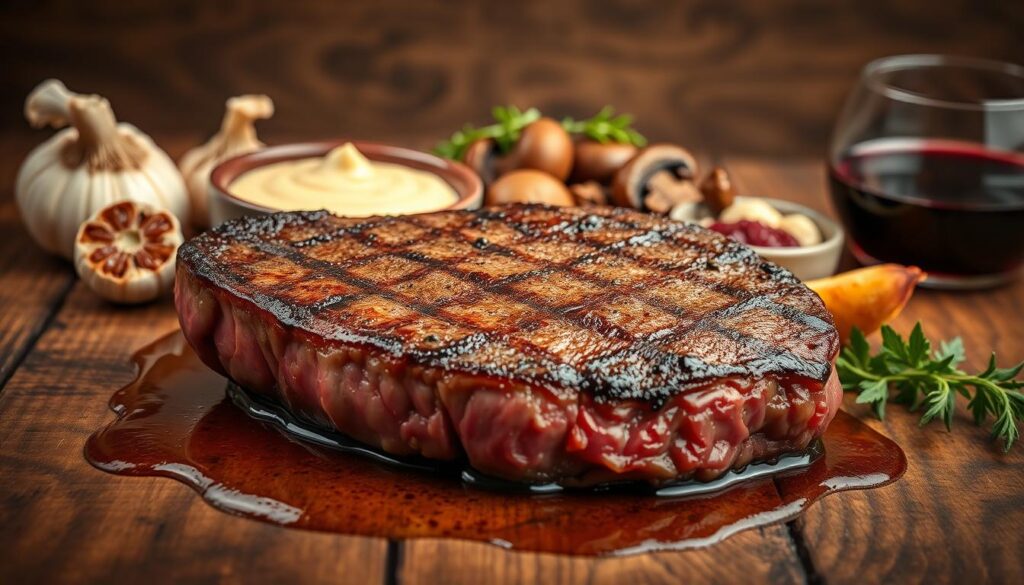
Wine Pairing Tips for Steak Lovers
Wine pairing can elevate your steak meal. A bold red wine is often a good match for beef. For example, cabernet sauvignon goes well with ribeye, while pinot noir suits filet mignon better. The steak’s temperature and the sides and sauces you choose also matter.
By carefully choosing sides, sauces, and wine, you can make your steak dinner unforgettable. Try different combinations to find your favorite.
Popular Steak Cuts and Their Internal Temps
To cook steak perfectly, knowing the internal temperature for each cut is key. Different cuts have unique qualities that affect their ideal temperatures. This knowledge is essential for achieving the perfect doneness.
Let’s look at three popular steak cuts: ribeye, filet mignon, and skirt steak. Each has its own temperature needs to enhance flavor and texture.
Ribeye: Flavor Profile and Cooking Tips
The ribeye is famous for its rich marbling, which adds flavor. Its marbling makes it forgiving at higher temperatures. Many like their ribeye cooked to medium, around 135-145°F. This temperature range makes the steak tender and flavorful.
When cooking ribeye, managing its muscles is key. Adjust cooking time and temperature to achieve this. A meat thermometer is vital to hit the right internal temperature.
Filet Mignon: Cooking Suggestions
Filet mignon is lean and tender, needing careful temperature control. It’s best not to go beyond medium-rare, around 130-135°F. This keeps it juicy and tender.
Because filet mignon has less marbling, it dries out easily if overcooked. So, precise temperature control is critical.
Skirt Steak: Doneness Guidelines
Skirt steak is flavorful but can be chewy. It cooks best quickly to medium-rare or medium, around 130-145°F. Slicing it thinly against the grain helps too.
Quick cooking over high heat is key for skirt steak. This method seals in flavors and textures, making it tender and delicious.
Understanding Your Grill or Oven
The secret to a perfect steak is knowing your cooking gear. Whether you grill or use an oven, each tool has its own way of changing your steak’s taste.
Key Temperature Settings for Grilling
Grilling needs precision, and temperature control is key. For a medium steak temperature, your grill must be set right. Grills have different heat zones: high, medium, and low. Knowing when to use each is important.
- High heat is great for searing steaks, making a crust and keeping juices in.
- Medium heat is best for cooking steaks to medium doneness, ensuring even cooking.
- Low heat is good for finishing steaks gently or keeping them warm without overcooking.
Grill experts say, “A great grilled steak isn’t just about the meat. It’s about controlling your grill’s temperature.”
“A good grill master knows that temperature control is key to achieving the perfect steak. It’s not just about throwing the steak on the grill; it’s about understanding how to use the grill’s heat to your advantage.”
| Doneness Level | Internal Temperature | Grill Setting |
|---|---|---|
| Rare | 120°F – 130°F | High Heat |
| Medium Rare | 130°F – 135°F | Medium-High Heat |
| Medium | 140°F – 145°F | Medium Heat |
Oven Temperature Control Tips
Oven cooking can also make a perfect steak. To get it right, calibrate your oven’s temperature. An oven thermometer helps check if your oven is at the right temperature.
For a medium steak, heat your oven to 400°F (200°C). Season your steak, then put it on a baking sheet or oven-safe skillet. Cooking times depend on your steak’s thickness and desired doneness.
Smoking and Its Effects on Steak Cooking
Smoking is a slow cooking method that adds deep flavors to your steak. When smoking, keep the temperature steady, between 225°F to 250°F (110°C to 120°C).
Smoking infuses the steak with smoke flavor over time. It’s perfect for thicker steaks, allowing for even cooking and tenderness.
To get a medium steak temperature when smoking, watch the internal temperature closely. The low heat makes it hard to tell doneness by cooking time alone.
The Science Behind Cooking Steak
Cooking steak is more than just throwing it on the grill. It’s a science that involves heat, proteins, and moisture. When you cook a steak, you’re changing its structure.
How Heat Affects Meat Proteins
Heat is key in cooking steak. It changes proteins, making the steak firmer and less juicy. This is why steak gets tougher as it cooks beyond medium-rare.
Knowing this helps you get the perfect doneness. Whether you want a tender medium-rare steak or a well-done piece, it’s all about the heat.
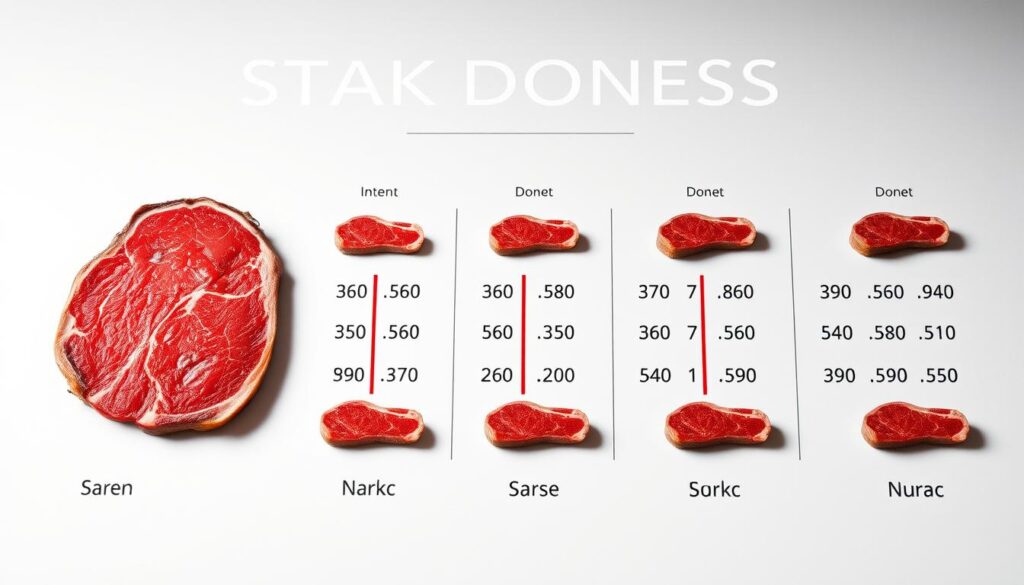
The Maillard Reaction Explained
The Maillard reaction happens when food cooks. It’s a chemical reaction that creates new flavors and browning. For steak, this reaction is vital for the flavorful crust.
To get the most out of this reaction, cook your steak at high temperatures. This is usually above 285°F. It not only boosts flavor but also improves texture and appearance.
Why Resting Meat Changes Texture
Resting your steak after cooking is essential. It lets protein strands relax and reabsorb juices. This makes the steak more tender and juicy.
Understanding resting can greatly enhance your steak’s quality. It makes for a better dining experience.
Managing Your Cooking Time
Getting your steak just right needs the right temperature and timing. The steak’s thickness, the grill or pan’s heat, and the meat’s starting temperature all matter. They all affect how long it takes to cook.
To cook your steak perfectly, timing is everything. Thicker steaks take longer, while thinner ones cook faster. The beef medium well temp is about 150°F to 155°F (65°C to 68°C). You’ll need to adjust the cooking time based on this.
Timing Your Steak for Perfect Doneness
First, think about your steak’s thickness. Cook it for 4-6 minutes per side for each inch. But, the exact time can change based on the heat and how done you want it.
| Steak Thickness | Rare (120°F – 130°F) | Medium Rare (130°F – 135°F) | Medium Well (150°F – 155°F) |
|---|---|---|---|
| 1 inch | 2-3 minutes per side | 3-4 minutes per side | 5-6 minutes per side |
| 1.5 inches | 4-5 minutes per side | 5-6 minutes per side | 7-8 minutes per side |
| 2 inches | 6-7 minutes per side | 7-8 minutes per side | 9-10 minutes per side |
How to Use a Timer Effectively
Using a timer is key to cooking a perfect steak. Set it based on the steak’s thickness and your desired doneness. Always check the steak’s temperature near the end to avoid overcooking.
Adjusting Cooking Times for Different Methods
Each cooking method changes the cooking time. Grilling is quicker than oven roasting. Adjust the time when switching methods. Remember, “carryover cooking” happens after removing the steak from heat. So, remove it 5-10°F before reaching your target temperature.
Mastering timing and understanding cooking factors leads to perfectly cooked steak every time. Whether aiming for a beef medium well temp or another doneness, timing is essential for a great meal.
Best Practices for Storing Leftover Steak
After enjoying your perfectly cooked steak, it’s essential to handle leftovers properly. This ensures they stay quality and safe. Proper storage and reheating techniques will keep your leftover steak delicious and safe to eat.
Cooling Down to Prevent Spoilage
To prevent bacterial growth, cool leftover steak quickly. Avoid sealing hot steak in airtight containers. This can trap heat and moisture, creating an ideal environment for bacteria. Instead, let the steak cool down to room temperature within two hours.
You can speed up the cooling process by placing the steak on a wire rack or a plate. This allows air to circulate around it.
Tip: Slice the steak into thinner pieces if you’re in a hurry. This will help it cool faster.
How to Reheat Steak Without Drying It Out
Reheating steak requires care to maintain its moisture and tenderness. One effective method is gentle oven warming. Preheat your oven to 200-250°F (90-120°C), and place the steak on a baking sheet lined with parchment paper.
Heat the steak until it reaches an internal temperature of 125-130°F. This should take about 10-15 minutes depending on the thickness.
Sous vide reheating is another excellent option. Simply place the steak in a sous vide water bath set to 130°F (54°C). Let it reheat for about 30 minutes to an hour. This method ensures that the steak is heated evenly throughout.
Creative Recipes for Leftover Steak
Leftover steak can be repurposed into a variety of delicious dishes. Consider making a steak salad. Slice the steak thinly and toss it with mixed greens, cherry tomatoes, and a tangy vinaigrette.
You can also create a steak sandwich. Layer sliced steak with caramelized onions and melted cheese on a crusty baguette.
For a different twist, try making breakfast steak and eggs. Slice the leftover steak into strips and pan-fry it with some onions and bell peppers. Serve it with scrambled eggs and toast for a hearty breakfast.
These creative recipes not only reduce food waste but also provide you with exciting new meals. They celebrate the flavor of your original steak.
Final Thoughts on Steak Cooking
Learning to cook steak well takes time, patience, and knowing about internal temperatures. Now, you know about different doneness levels and the right internal temperatures. It’s time to use this knowledge to cook great steaks.
Key Temperature Takeaways
The internal temperatures for steak are: rare (120-125°F), medium-rare (130-135°F), medium (140-145°F), medium-well (150-155°F), and well-done (160°F+). Wondering about medium rare? It’s between 130-135°F. Use this guide to cook your steak just right.
Experiment and Refine Your Skills
Don’t worry if you don’t get it perfect every time. Even top chefs sometimes miss their mark. The important thing is to keep trying different cuts, cooking methods, and temperatures to find what you like best.
Continuing Your Steak Cooking Journey
Want to keep learning? Check out books, websites, and cooking courses on steak cooking. They’ll help you get better at cooking steak and learn more about cooking in general.
FAQ
What is the ideal internal temperature for a medium-rare steak?
How do I measure the internal temperature of a steak?
What is the recommended internal temperature for cooking steak to different levels of doneness?
Why is it important to let steak rest after cooking?
How do different cooking methods affect the internal temperature of steak?
What is the USDA’s recommended internal temperature for beef?
How do I reheat leftover steak without drying it out?
Can I use a meat thermometer for other types of meat beside steak?
How do I know when to remove steak from heat?
What are some common mistakes to avoid when cooking steak?
For more cooking tips, stay connected with us. We also recommend the cookbook Skinnytaste Simple: Easy, Healthy Recipes with 7 Ingredients or Fewer
For more Recipes about Steak ?
Did You try our recipe ?
There are no reviews yet. Be the first one to write one.
